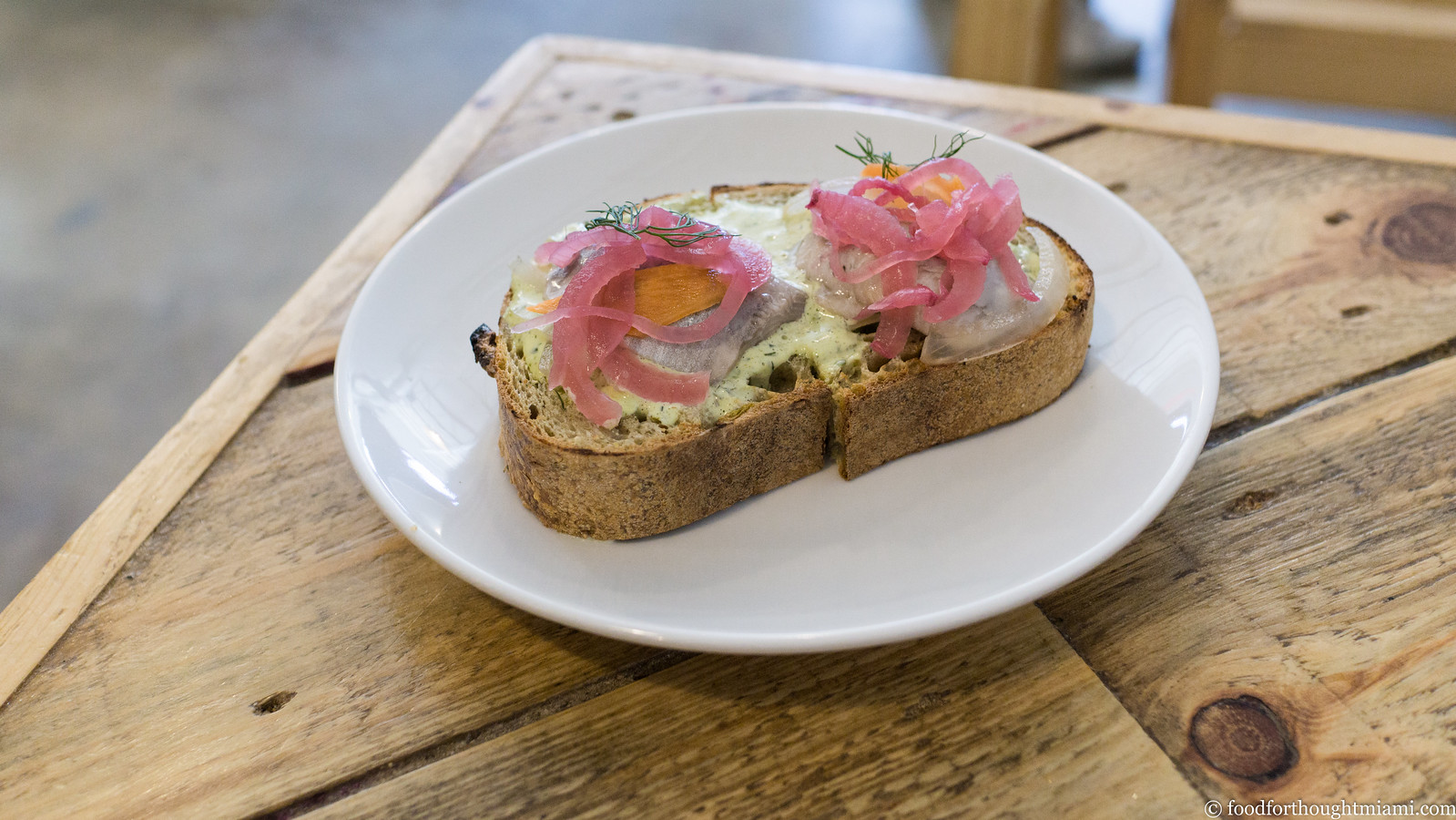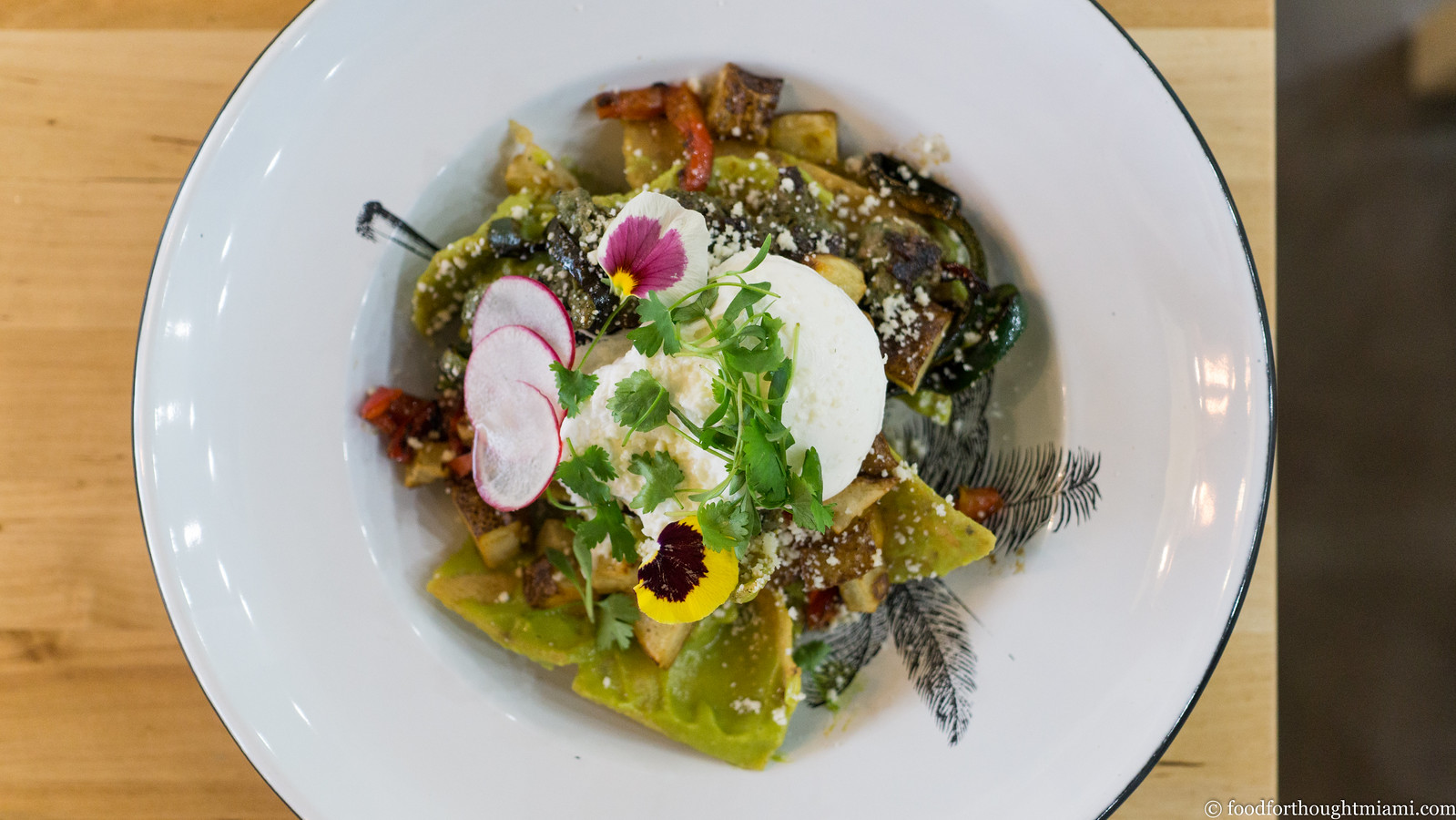Monday, September 21, 2015
best thing i ate last week: schmaltz herring toast at Zak the Baker
It was the first thing I ate at Zak the Baker when the Wynwood café opened last May: a toasted slab of his fantastically crusty, naturally leavened multigrain bread, topped with slick, fatty brined schmaltz herring and pickled onions. On that first visit, it was paired with a 10 a.m. vodka shot which Zak rightfully insisted was an essential accompaniment.
This past Sunday morning, there was mercifully no hard liquor, but there was that same delicious fish, that same delicious bread, those same tart onions, though a pickle-infused aioli substituted for the creamy creme fraiche of that first visit. Still mighty good. And the best thing I ate last week. Pro tip: ZTB gets crazy busy with Sunday brunchers, but still keeps baker's hours, and opens at 7 a.m. If you can rouse yourself early, you may be able to squeeze in before the crowds.
Runner up: a classic from chef Michelle Bernstein's repertoire, on the menu at her Miami Beach restaurant, Seagrape: a delicately fried squash blossom stuffed with shrimp mousseline, served over a bed of creamy corn grits and dappled with a rich seafood nage.
Saturday, September 19, 2015
a message from the future
A couple weeks ago Eater Miami asked me, "What do you think the future of dining looks like?" Some of my comments ran yesterday along with responses from several other locals as part of a series of "Future Week" stories across the Eater network. It may not surprise you that I actually had a bit more to say on the subject. Here's an expanded version of my thoughts on the future of dining, particularly in South Florida.
There is already movement in this direction, and the political push for minimum wage increases plus the shortage of line cooks will create increasing pressure to even out front-of-house and back-of-house compensation. (Sooner or later the light bulb will go off that there's a connection between the low wages for kitchen employees and their scarcity). Putting service staff on salary without a tip credit will be a big shift, but possibly a necessary one.
On my last visits to the Bay Area, several places were either adding a "service charge" or doing "service included" bills (Comal and Ippuku in Berkeley, Camino in Oakland). There have been some interesting success stories, including a couple places that give long-term employees a small share of ownership. Just this week, Tom Colicchio announced he is going to a no-tip, price-inclusive-of-service program during lunch service at Craft. There have also been places that tried, and ultimately balked, at using all-inclusive, no-tip pricing (Aster in San Francisco comes to mind).
In Miami, anyway, we're already accustomed to seeing "gratuity added" (or not seeing it clearly marked on the bill, but still having it done!). It would make little difference to the diner if instead, it was "service included" that gets shared with BOH and FOH, but it would require a change in how the restaurants operate.
One arguable financial upside to making this shift for restaurateurs: it will mitigate the risk of wage violation lawsuits that often arise from asserted non-compliance with tip credit requirements. Perhaps not coincidentally, Colicchio's restaurants have twice been sued for wage violations – once back in 2008 (a case that was settled), and more recently this year in connection with 'wichCraft (he pointedly denies the latest allegations). These lawsuits can be high-stakes stuff: in 2008, Jean-Georges Vongerichten paid $1.75 million to settle wage claims; in 2009 Nobu paid $2.5 million for similar claims; in 2012, Mario Batali and Joe Bastianich's restaurants paid $5 million in a settlement.
See 1. Increasing wages will put even more pressure on thin margins; eventually the cost of dinner will have to go up.
See 1, 2. If the cost of labor is going up, and you have limited ability to raise prices, then you'll have to figure out how to get by with less employees. I expect there will be more "fast casual" type places, and that it will be increasingly difficult to successfully operate a moderately priced sit-down restaurant. Miami chef Alberto Cabrera recently made this shift, turning his Coral Gables restaurant Bread & Butter from a sit-down place into Little Bread, with counter service sandwiches and bowls, and I think it will prove to be a good move for him. Big picture, though, this bums me out, and I hope I'm wrong. Some of my favorite restaurants are the mid-range places where you can find interesting, ambitious food without it being a hundred dollar meal to pay for a million dollar build-out. I worry these will become an endangered species.
Everything can't be in Wynwood, South Beach or Brickell. And there are huge parts of Miami-Dade County with lots of population density, lower rents, and little restaurant competition other than chains, like Doral and Kendall. Closer to Miami's urban core, you're already seeing it happen in Edgewater (Mignonette) and the Upper East Side (Vagabond, Cena by Michy, Blue Collar, etc.), and I think the push northward up Biscayne Boulevard will continue. And maybe just a bit west too: Little Haiti?
Some of them may be great. They all won't be. And it may prove tough to fill so many big dining rooms, even if you''re a "celebrity chef." Just ask Fabio Vivani. Or Tony Mantuano. Or Geoffrey Zakarian. Or – hot off the presses – Masaharu Morimoto, who announced just yesterday that he is closing his restaurant in the Shelborne on South Beach after exactly a year. Or ....
1. Tipping may become a thing of the past.
There is already movement in this direction, and the political push for minimum wage increases plus the shortage of line cooks will create increasing pressure to even out front-of-house and back-of-house compensation. (Sooner or later the light bulb will go off that there's a connection between the low wages for kitchen employees and their scarcity). Putting service staff on salary without a tip credit will be a big shift, but possibly a necessary one.
On my last visits to the Bay Area, several places were either adding a "service charge" or doing "service included" bills (Comal and Ippuku in Berkeley, Camino in Oakland). There have been some interesting success stories, including a couple places that give long-term employees a small share of ownership. Just this week, Tom Colicchio announced he is going to a no-tip, price-inclusive-of-service program during lunch service at Craft. There have also been places that tried, and ultimately balked, at using all-inclusive, no-tip pricing (Aster in San Francisco comes to mind).
In Miami, anyway, we're already accustomed to seeing "gratuity added" (or not seeing it clearly marked on the bill, but still having it done!). It would make little difference to the diner if instead, it was "service included" that gets shared with BOH and FOH, but it would require a change in how the restaurants operate.
One arguable financial upside to making this shift for restaurateurs: it will mitigate the risk of wage violation lawsuits that often arise from asserted non-compliance with tip credit requirements. Perhaps not coincidentally, Colicchio's restaurants have twice been sued for wage violations – once back in 2008 (a case that was settled), and more recently this year in connection with 'wichCraft (he pointedly denies the latest allegations). These lawsuits can be high-stakes stuff: in 2008, Jean-Georges Vongerichten paid $1.75 million to settle wage claims; in 2009 Nobu paid $2.5 million for similar claims; in 2012, Mario Batali and Joe Bastianich's restaurants paid $5 million in a settlement.
2. Expensive restaurants will become even more expensive.
See 1. Increasing wages will put even more pressure on thin margins; eventually the cost of dinner will have to go up.
3. Lower end restaurants will look for ways to reduce staff.
See 1, 2. If the cost of labor is going up, and you have limited ability to raise prices, then you'll have to figure out how to get by with less employees. I expect there will be more "fast casual" type places, and that it will be increasingly difficult to successfully operate a moderately priced sit-down restaurant. Miami chef Alberto Cabrera recently made this shift, turning his Coral Gables restaurant Bread & Butter from a sit-down place into Little Bread, with counter service sandwiches and bowls, and I think it will prove to be a good move for him. Big picture, though, this bums me out, and I hope I'm wrong. Some of my favorite restaurants are the mid-range places where you can find interesting, ambitious food without it being a hundred dollar meal to pay for a million dollar build-out. I worry these will become an endangered species.
4. More independent restaurants in less trendy neighborhoods.
Everything can't be in Wynwood, South Beach or Brickell. And there are huge parts of Miami-Dade County with lots of population density, lower rents, and little restaurant competition other than chains, like Doral and Kendall. Closer to Miami's urban core, you're already seeing it happen in Edgewater (Mignonette) and the Upper East Side (Vagabond, Cena by Michy, Blue Collar, etc.), and I think the push northward up Biscayne Boulevard will continue. And maybe just a bit west too: Little Haiti?
5. 50% of the big-name chef restaurants that are opening in Miami won't be around after two years.
Some of them may be great. They all won't be. And it may prove tough to fill so many big dining rooms, even if you''re a "celebrity chef." Just ask Fabio Vivani. Or Tony Mantuano. Or Geoffrey Zakarian. Or – hot off the presses – Masaharu Morimoto, who announced just yesterday that he is closing his restaurant in the Shelborne on South Beach after exactly a year. Or ....
Monday, September 14, 2015
best thing i ate last week: chilaquiles verdes at Centro Taco
My first visit to Centro Taco was in late July, the day after they opened. And I was pretty excited by what I found: house-made tortillas rolled out at a workstation in the middle of the dining room, serving as vehicles for toppings which paid more heed to flavor than rigid authenticity. There were gator pibil tacos, duck carnitas tacos, and best of all, a gordita topped with Haitian style griots and pikliz that was the best thing I ate that week.
I finally got back for a second visit this past Saturday, when Chef Richard Hales features a brunch menu in much the same spirit. My favorite of the few things I tried was his version of chilaquiles. Fried tortilla shards are softened with salsa verde,[1] and serve as the base for a potato and pepper hash, poached egg, and some Proper Sausages chorizo verde flecked with green chiles and herbs. Slivered radishes, fresh cilantro, and yeah, some flower petals – because Richard's a sensitive vegan who likes flowers now – finish the dish. It was the best thing I ate last week.
(You can see all my pictures in this Centro Taco - Miami flickr set).
[1] In my mind anyway, there's a weird affinity between Mexican chilaquiles and Jewish matzo brei. But I suppose lots of food cultures use the same trick of refreshing stale breadstuffs with a soak in some flavorful liquid or egg: Spanish migas, French pain perdu.
Subscribe to:
Posts (Atom)



